
Scaevola is a genus of flowering plants in the Goodenia family, Goodeniaceae. It consists of more than 130 species, with the center of diversity being Australia and Polynesia. There are around 80 species in Australia, occurring throughout the continent, in a variety of habitats. Diversity is highest in the South West, where around 40 species are endemic.

Johann Jacob Dillen Dillenius was a German botanist. He is known for his Hortus Elthamensis on the rare plants around Eltham, London, and for his Historia muscorum, a natural history of lower plants including mosses, liverworts, hornworts, lycopods, algae, lichens and fungi.

Briza is a genus of annual and perennial plants in the grass family, native to northern temperate regions of Eurasia, North Africa, and certain islands in the Atlantic.

Dactylis is a genus of Eurasian and North African plants in the bluegrass subfamily within the grass family. Dactylis is native to North Africa, they are found throughout the world, and are an invasive species. They are known in English as cock's-foot or cocksfoot grasses, also sometimes as orchard grasses.

Eriophorum is a genus of flowering plants in the family Cyperaceae, the sedge family. They are found in the cool temperate, alpine, and Arctic regions of the Northern Hemisphere, primarily in the middle latitudes of North America, Europe, and Asia.

Supplementum Plantarum Systematis Vegetabilium Editionis Decimae Tertiae, Generum Plantarum Editiones Sextae, et Specierum Plantarum Editionis Secundae, commonly abbreviated to Supplementum Plantarum Systematis Vegetabilium or just Supplementum Plantarum, and further abbreviated by botanists to Suppl. Pl., is a 1782 book by Carolus Linnaeus the Younger. Written entirely in Latin, it was intended as a supplement to the 1737 Genera Plantarum and the 1753 Species Plantarum, both written by the author's father, the "father of modern taxonomy", Carl Linnaeus.

Uniola is a genus of New World plants in the grass family.
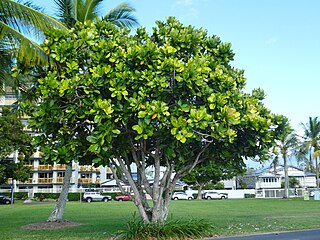
Barringtonia asiatica, also known as fish poison tree, putat or sea poison tree, is a species of Barringtonia native to mangrove habitats from islands of the Indian Ocean in the west to tropical Asia and islands of the western Pacific Ocean.

Desmazeria is a genus of Mediterranean plants in the grass family, related to Catapodium.
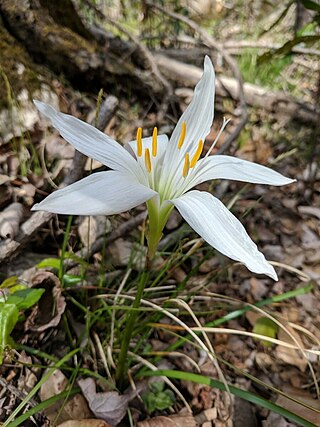
Zephyranthes atamasca, commonly known as the atamasco-lily or more generally a rain-lily, is native to the southeastern United States. It grows in swampy forests and coastal prairies, preferring acid boggy soils rich with leaf mold. Following the appearance of broad, grassy leaves in early winter, it blooms in March or April. It has several narrow, linear basal leaves about 0.5 in (13 mm) wide and 10–15 in (25–38 cm) long. Its native range extends from Florida north to Maryland and west to Mississippi. The species is also naturalized in Bermuda and in the Mariana Islands. Both its leaves and bulbs are poisonous.

Strelitzia alba also known as white-flowered wild banana, or Cape wild banana is a plant of the Bird of Paradise family and is endemic to the Garden Route along the southernmost coastal regions of the district of Humansdorp Eastern and district of Knysna in Western Cape in South Africa. It grows in evergreen forest, gorges, and on slopes along the rivers.

Evolvulus alsinoides, commonly known as dwarf morning-glory and slender dwarf morning-glory, is flowering plant from the family Convolvulaceae. In Indian ayurveda, it is commonly known as Visnukranta or Shankhavel. It has a natural pantropical distribution encompassing tropical and warm-temperate regions of Australasia, Indomalaya, Polynesia, Sub-Saharan Africa and the Americas.
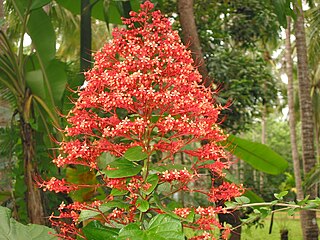
Clerodendrum paniculatum, the pagoda flower, is a species of flowering plant in the genus Clerodendrum and family Lamiaceae. It is native to tropical Asia and Papuasia, Fiji, and French Polynesia. It is introduced in Central America.

Mantissa Plantarum Altera is an illustrated book with botanical descriptions which was edited by the Swedish naturalist Carl Linnaeus in the year 1771.
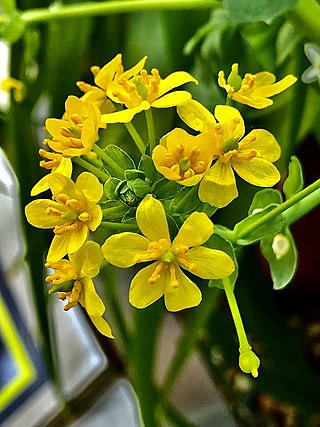
Leontice is a group of perennial, tuberous herbs in the family Berberidaceae, first described as a genus by Linnaeus in 1753.

Tribolium is a genus of African plants in the grass family, native to South Africa and neighboring countries.

Rottboellia cochinchinensis is a species of grass known by the common names Itchgrass,Raoul grass, corngrass, Kokoma grass, Guinea-fowl grass, jointed grass, Shamwa grass and Kelly grass. It is a tall, tufted annual grass whose stems (culms) grow up to 3 metres in height with leaf-blades of up to 45 centimetres in length. The species flowers at the apex of culms in the form of spike-like racemes composed of paired spikelets. The common name Itchgrass comes from the bristly (hispid) leaf-sheath which can be irritating to the skin.
Élisabeth Julienne Pommereul was a French botanist who worked under the teachings of the French botanist Thouin and Swedish botanist Linnaeus to study classifications and counts of grass types in the Jardin du Roi.

Elatine hydropiper is a species of flowering plant belonging to the family Elatinaceae.
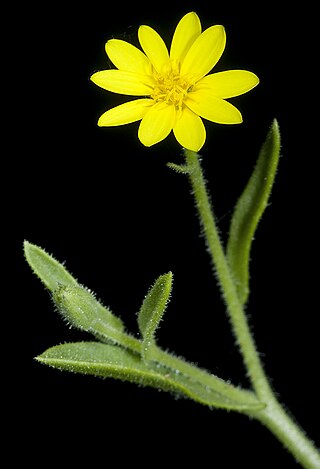
Osteospermum calendulaceum is a plant in the family Asteraceae. It was first described in 1782 by Carl Linnaeus the Younger. In 1832, Christian Friedrich Lessing assigned it to the genus Oligocarpus in his Synopsis Generum Compositarum.






















